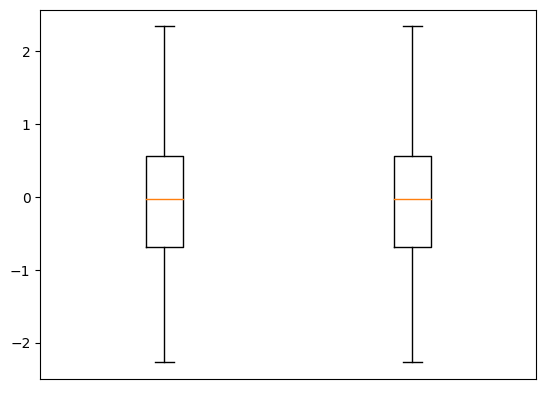Python matplotlib 画图入门 10 画盒图 boxplot
REF
https://matplotlib.org/stable/api/_as_gen/matplotlib.pyplot.boxplot.html
https://matplotlib.org/stable/gallery/statistics/boxplot_demo.html
https://stackabuse.com/matplotlib-box-plot-tutorial-and-examples/
https://www.scaler.com/topics/matplotlib/boxplot-matplotlib/
https://www.javatpoint.com/box-plot-in-python-using-matplotlib
https://www.nickmccullum.com/python-visualization/boxplot/




For those unfamiliar with the terminology of this diagram, they are described below:
- Q1: The first quartile of the dataset. 25% of values lie below this level.
- Q2: The second quartile of the dataset. 50% of values lie above and below this level.
- Q3: The third quartile of the dataset. 25% of values lie above this level.
- The boxplot 'Minimum', defined as Q1 less 1.5 times the interquartile range.
- The boxplot Maximum, defined as Q3 plus 1.5 times the interquartile range.
- The median: the midpoint of the datasets.
- Interquartile range: the distance between Q1 and Q3.
- Outliers: data points that are below Q1 or above Q3.
import numpy as np import matplotlib.pyplot as plt #generate some random data data = np.random.randn(200) ## 产生200个 标准正态分布数字, d = [data, data] ### 两组一样的数字; list #plot box = plt.boxplot(d, showfliers=False) ## 画盒图 plt.xticks([]) plt.show()

#-----import packages-----# #common python packages import numpy as np import matplotlib.pyplot as plt #generate some random data data1 = np.random.randn(10) ## 产生10个 标准正态分布数字, data2 = np.random.randn(10) data3 = np.random.randn(10) data4 = np.random.randn(10) data5 = np.random.randn(10) d=np.vstack((data1,data2,data3,data4,data5)) print(d.shape) print(d.ndim) #plot box = plt.boxplot(d, showfliers=False) ## 画盒图 plt.xticks([]) plt.show()

import matplotlib.pyplot as plt import numpy as np from matplotlib.patches import Polygon # Fixing random state for reproducibility np.random.seed(19680801) # fake up some data spread = np.random.rand(50) * 100 center = np.ones(25) * 50 flier_high = np.random.rand(10) * 100 + 100 flier_low = np.random.rand(10) * -100 data = np.concatenate((spread, center, flier_high, flier_low)) fig, axs = plt.subplots(2, 3) # basic plot axs[0, 0].boxplot(data) axs[0, 0].set_title('basic plot') # notched plot axs[0, 1].boxplot(data, 1) axs[0, 1].set_title('notched plot') # change outlier point symbols axs[0, 2].boxplot(data, 0, 'gD') axs[0, 2].set_title('change outlier\npoint symbols') # don't show outlier points axs[1, 0].boxplot(data, 0, '') axs[1, 0].set_title("don't show\noutlier points") # horizontal boxes axs[1, 1].boxplot(data, 0, 'rs', 0) axs[1, 1].set_title('horizontal boxes') # change whisker length axs[1, 2].boxplot(data, 0, 'rs', 0, 0.75) axs[1, 2].set_title('change whisker length') fig.subplots_adjust(left=0.08, right=0.98, bottom=0.05, top=0.9, hspace=0.4, wspace=0.3) # fake up some more data spread = np.random.rand(50) * 100 center = np.ones(25) * 40 flier_high = np.random.rand(10) * 100 + 100 flier_low = np.random.rand(10) * -100 d2 = np.concatenate((spread, center, flier_high, flier_low)) # Making a 2-D array only works if all the columns are the # same length. If they are not, then use a list instead. # This is actually more efficient because boxplot converts # a 2-D array into a list of vectors internally anyway. data = [data, d2, d2[::2]] # Multiple box plots on one Axes fig, ax = plt.subplots() ax.boxplot(data) plt.show()




